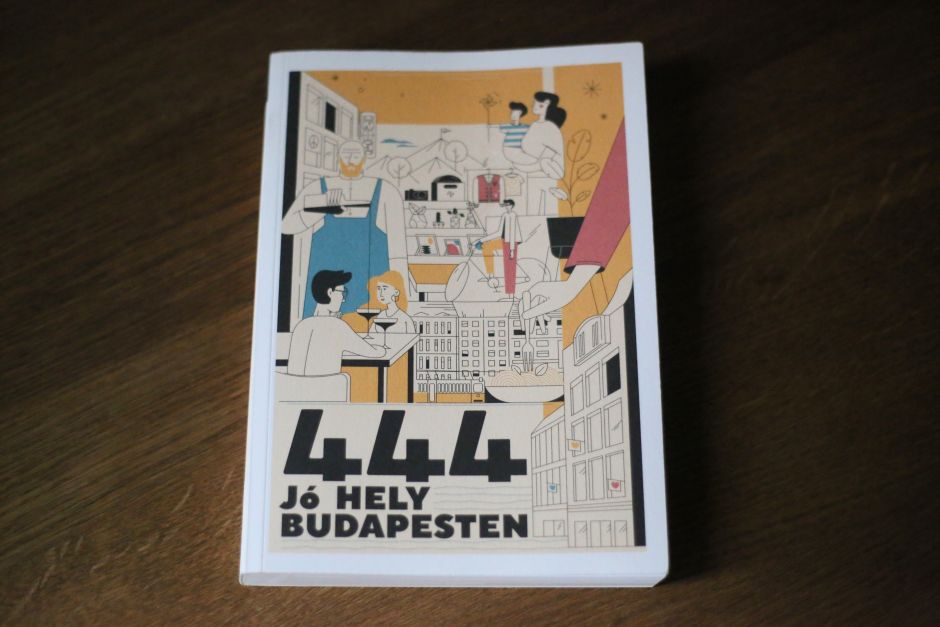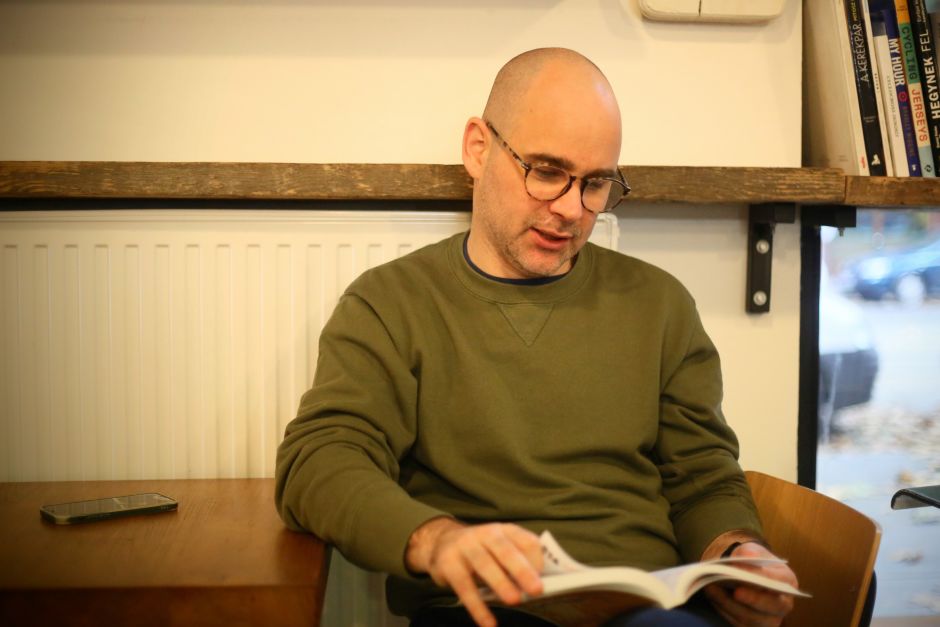
Márton Bede is a journalist at 444. He covers many beats, but recently his forte has been Budapest, especially new places that are popping up across the city. Restaurants, bars, cultural venues, undiscovered hiking destinations, you name it. He’s the main author of the recently published book, "444 jó hely Budapesten," featuring a sweeping collection of his favorites. I always enjoy bouncing ideas off him – his takes are snappy, witty, and fun, as is the book itself.
Has writing this Budapest guide shaped the way you view the city?
Shaping is maybe too strong a word, but it was interesting to observe how the city is changing, what is different from four years ago, when we first published the book. Back in 2018, you could already see the massive property development projects taking place along the main roads connecting the city center to the suburbs. Váci út, Soroksári út, Budafoki út and a couple of others have seen huge housing and office complexes go up. Unfortunately, there is no political will to force the developers to also do some urban planning or think about the needs of future owners and tenants.
When the big Soviet-style housing estates went up in the 1970s, the communists were wise enough to actually do some planning, from bus stops to kindergartens. Not much of this happens today, developers sell the units, and then it’s up to the people moving in and local governments to figure out the rest.
This doesn’t sound too promising.
Four years ago, these newly built districts were completely soulless. But human life always finds a way, so they are in much better shape now. I’m not sure about bus stops and kindergartens, but cafes, restaurants and many other businesses have moved into ground floor retail spaces. In the first book, most featured places were in the city center, but this time around it was nice to see that there are actually good cafes near Váci út, for example Café Tripoli, and good barbecue restaurants near Budafoki út, such as DPBBQ.

Were there any unexpected discoveries while researching this book?
Yes, but I’m not going to give them all away. So here are two very different ones. Marlou, the small wine bar behind the Opera House that you recommended to me is truly lovely, even for a person like me, who doesn’t really care about wine. And then there is Breadpit, a fantastic bakery-café-social center out in the leafy part of District 14. It’s typical of what I’ve mentioned above: great places far from the center.
You live in a part of District 9 (Ferencváros) to which few tourists usually make it. Can you talk about this neighborhood?
Ferencváros does see a large number of tourists, since many of them visit the Great Market Hall. To be honest, I’ve yet to see a less interesting main market in a capital city, and I’ve been to many.
District 9 is actually one of the more diverse parts of Budapest, with three easily distinguishable sections. Belső-Ferencváros (Inner) is the area between Kálvin tér, Szabadság híd, and the Körút (Grand Boulevard). It’s a typical city center microdistrict lined with neoclassical buildings. Then there is Középső-Ferencváros (Middle), stretching from the Körút to Haller utca, a mixture of early-20th-century buildings, a massive housing development from the turn of the Millenium, and some buildings going up right now. Külső-Ferencváros (Outer) has the huge Soviet-style József Attila housing estate and some even more suffocating ones built in the last couple of years.
Which part do you live in?
I’m in Középső-Ferencváros. True, not many tourists come here, but this is still one of the more international parts of Budapest. SOTE (Semmelweis), the big medical university, has hundreds of foreign students, and Corvinus University also draws quite a few of them. There is also a surprisingly large Indian community, drawn to the multinational companies headquartered on the Danube's bank. The neighborhood has a mix of these expats, young families, some old pensioners, and even some Roma people living in the more run-down buildings.
What are some of the places here a first-time visitor shouldn’t miss?
Take a walk down Tompa utca, one of the leafiest streets in Budapest, connecting the Körút to Ferenc tér, the social hub of Középső-Ferencváros. My two favorite places along Tompa are Manfréd, a bakery, and Crafty, a tiny craft beer bar with a lovely terrace on warm evenings. They serve a couple of Hungarian brews on tap, and about 150 by the bottle or can.
Next door to them is Pancs Bolt, a small organic/zero waste deli. Pancs organizes a farmers’ market on Sundays two blocks away, inside Élesztőház. I shop there almost every week; they have everything from proper Greek olives to good Hungarian sausages and usually offer a simple warm meal for lunch. Élesztőház was one of the first big craft beer bars in Budapest, now it’s more like a hub of beer pubs, wine bars, cafes, and restaurants, all perfectly fine. It actually has some of the ruin-bar feel of the early 2000s that none of the places in District 7 have (even though they market themselves as ruin bars to tourists).
I like this list. Can you mention a few more places?
Salve serves decent Neapolitan-style pizza; go for the spicy nduja. Mesterbike is a fancy bike shop and cafe, with a communal table where you can pretend to work on your laptop while chatting with other regulars.
There are two places just on the other side of Üllői út, so technically in District 8, but definitely worth the 10-minute walk from my home. One is Kicsi Japán Sushi, run by a Japanese guy and offering the true Japanese experience of good food inside a tiny place hidden in an impossibly weird spot. In this case, this happens to be one of the dirtiest, noisiest, and stinkiest stretches of a road anywhere in Budapest. The other is Cintányéros, probably the best drinking joint in Budapest, with lovely and knowledgeable hosts, a good selection of wines, and simple, delicious bar food.
Finally, a good place for a sundowner is Nehru-part in Belső-Ferencváros, pretty much the only inner-city park on the Danube bank; there are a couple of river-facing bars next to it.

Are there other neighborhoods you’re partial to?
The one part of town that sees relatively few tourists for the number of its bars and restaurants is Bartók Béla út. Kelet kávézó and Caphe Hai Nam, a Vietnamese cafe/breakfast place, are my two favorites there.
Where do you normally go to see local art or music in Budapest?
I stick to music. Growing up, we had to drive two hours to Vienna (and two hours back) to see good shows. This is slowly changing, decent international acts now regularly visit Budapest, and not just for that one week in August during Sziget Festival.
Unfortunately, Covid and other misfortunes have killed off some good venues, and nothing has replaced them yet. The one good central techno club (Lärm) has closed, so now you have to commit to traveling to industrial wastelands located on the edges of town, such as Flashback, if you want to dance until sunrise. Some might say this is actually a good thing, but I’m too old for this. Turbina, partly run by friends, is fighting a never-ending battle with the local government. I hope they prevail, and then we’ll have a venue worth checking out regularly.
How about music festivals besides Sziget?
Two good music festivals deserve mention. UH, held every autumn across various cool venues in Budapest, focuses on the more experimental strains of popular music. Kolorádó, which I co-own, takes place on the first weekend of July. It’s located on the border of Budapest and the Buda hills, in a scout camp. It’s a lovely setting inside a forest, centered on a big meadow. The majority of top Hungarian bands play there and we always have a couple of international headliners – Black Midi and Sega Bodega in 2022 – and loads of DJs.
Do you have a favorite museum?
The best small museum is Miksa Róth’s former atelier. Róth specialized in stained glass mosaics in the early 20th century, and his works are some of the high points of Hungarian Art Nouveau and Art Deco. His most spectacular surviving mosaics can be seen on the facade of the Török Bankház, a wonderful Art Nouveau building in the city center.
What tip do you have for visitors to get the most out of their time in the city?
Check out how actual Hungarians live. A good method I have used in big cities around the world is to take the subway to a random stop close to the end of the line, and go for a long walk there. On the blue line, this could be Újpest-központ, on the red line, Déli pályaudvar, and on the green line, Bikás park or II. János pál pápa tér. Budapest is a super safe city, even at night, probably way safer than where you come from, and you are unlikely to starve.
If you have time for a day-trip, go for an excursion to the Buda Hills, maybe starting from Normafa. It’s amazing how close nature is to what is a fairly big European capital. If you want to see something truly offbeat and unique, check out Guttmann tó (also called Újhegyi horgásztó), a tiny fish-filled lake by one of the biggest Soviet housing estates way out on the edge of Pest. It’s a bizarre but lovable relic with strong 1980s vibes and fat old men clutching their fishing rods on the waterbank with massive buildings towering above them.
Any parting words of wisdom?
As a tourist, you will end up drinking in District 7. Either go to Madách tér, where two bars (Központ and Telep) draw the cool student crowd, or the two bars in Dob utca (Fekete Kutya and Kisüzem), with an older, alternative-bohemian vibe.
Do not, under any circumstance, enter any restaurant that advertises traditional Hungarian food in English. Go to Szépilona, way out in Buda, or Szaletly in Pest, if you want to eat in a restaurant where good, modernized Hungarian fare is served to upper-middle class Hungarians.